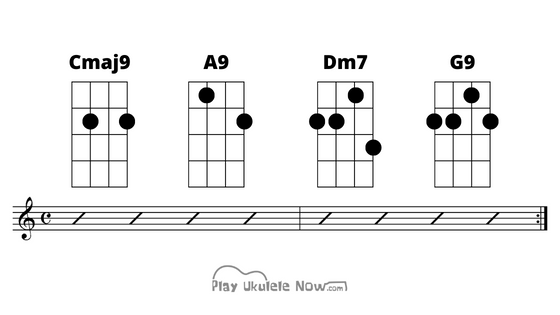Or as a sub for any chord!
You will Learn More and Play More with Play Ukulele NOW.
Find out for yourself why teachers and students have depended on Play Ukulele NOW Methods and Songbooks since 2009
Find out for yourself why teachers and students have depended on Play Ukulele NOW Methods and Songbooks since 2009
Find all my chord related posts here: Chord Tips and Tricks
Previously we've talked about the following:
Embellishments for the I (or IV) chord are:
- 6 (major 6 chord) - Happy and relaxing - Used for endings
- Major 9 - Relaxing and restful
- 6/9 (major chord) - Warm, sweet and mellow
- Major 9 #11 - Floating, pleasing, slightly unresolved
Embellishments for the ii (iii, or vi) chord are:
- Minor 7b5 - Enchanting and beautifully balanced (half diminished chord but not used here as one)
- Minor 9 - slightly dissonant, but bluesy and sophisticated sound
- Minor 11 - sophisticated, soulful 'rainy day' sound
This is the continuation of my "Ukulele Chords and How to Use Them" Series, in this lesson we look at the dominant 9.
Any Dominant (or altered dominant*) can be subbed for the V chord (or any other chord); as we've learned previously - any chord can be a dominant. And we've seen this in action in a blues progression as well.
In many blues progressions all the chords are dominant 7's - but they could be any dominant chord or any combination dominants (9's; 13's) and other chords.
Most commonly we'll find the dominant 9 as a sub (or embellishment) for the V chord...
The two most common dominant subs for the V chord are the dominant 9 and the dominant 13, the other popular subs would be altered dominant chords...
*Altered dominants can't be used for the I chord unless you play an unaltered V7 first (unless your name is Jimi Hendrix or SRV - then you may use a dominant 7#9 for the I chord in as many songs as you like). Remember: There are exceptions to every rule.
Check out the dominant 9
Listen to each...
What do you think?
Each one is unstable - and pulls towards the tonic.
Lets look at how each resolves to the tonic...
Here is it with the G7
And here with the G9
You'll notice a more intense resolution with the dominant 9; the 9th tone is the 6th tone of the tonic...
You may find the dominant 9 to have an exciting feeling of movement.
About the dominant 9 chord
The dominant 9 consists of 5 tones; the root note (1); a major third (3); a perfect fifth (5); a minor 7 (b7); and the 9th tone (9).
To make the dominant 9 we take a dominant 7 chord and raise the root note 1 step (two frets).
These - like many of the most effective ukulele chord forms - are based on 'drop two' jazz guitar chord from. A jazz guitar player may play these exact forms on the guitar.
Many of the forms for these chords you might find on the internet and in chord books may include the root note and not the 5th - If you've run across them you may have noticed that they are harder to use and harder to play.
Dominant chords are written (for the chord symbol) without the word 'dominant' like so: C9 or G9. Major or minor 9's always include the words 'major' or 'minor.'
Let's look at some progressions using dominant 9's
Here it is as the V in a I - VI - ii - V with a dominant 9 for the V:
Here we take a ii - V - I and use a dominant 9 for the ii and the V and we resolve with a major 6:
Here we make the vi and the V dominant 9's, and use a major 9 for the I chord in a I - vi - ii - V:
The rule here is "any chord can be a dominant" so have some fun...
To learn how to create beautiful chord progressions in any key get my "Secrets of the Chord Chain" books.
RELATED VIDEO
In this video we look at the rule 'Any chord can be a dominant'
Do me a favor and 'like' the video on YouTube and post a comment (on YouTube) to let me know what you think - thanks!
GRAB a PDF of this beautiful CHEAT CHEET (patreon) and an addition cheat sheet DOMINANT 7 to DOMINANT 9 (patreon)





.png)

.png)









.png)
brilliant, brilliant, brilliant!
ReplyDelete